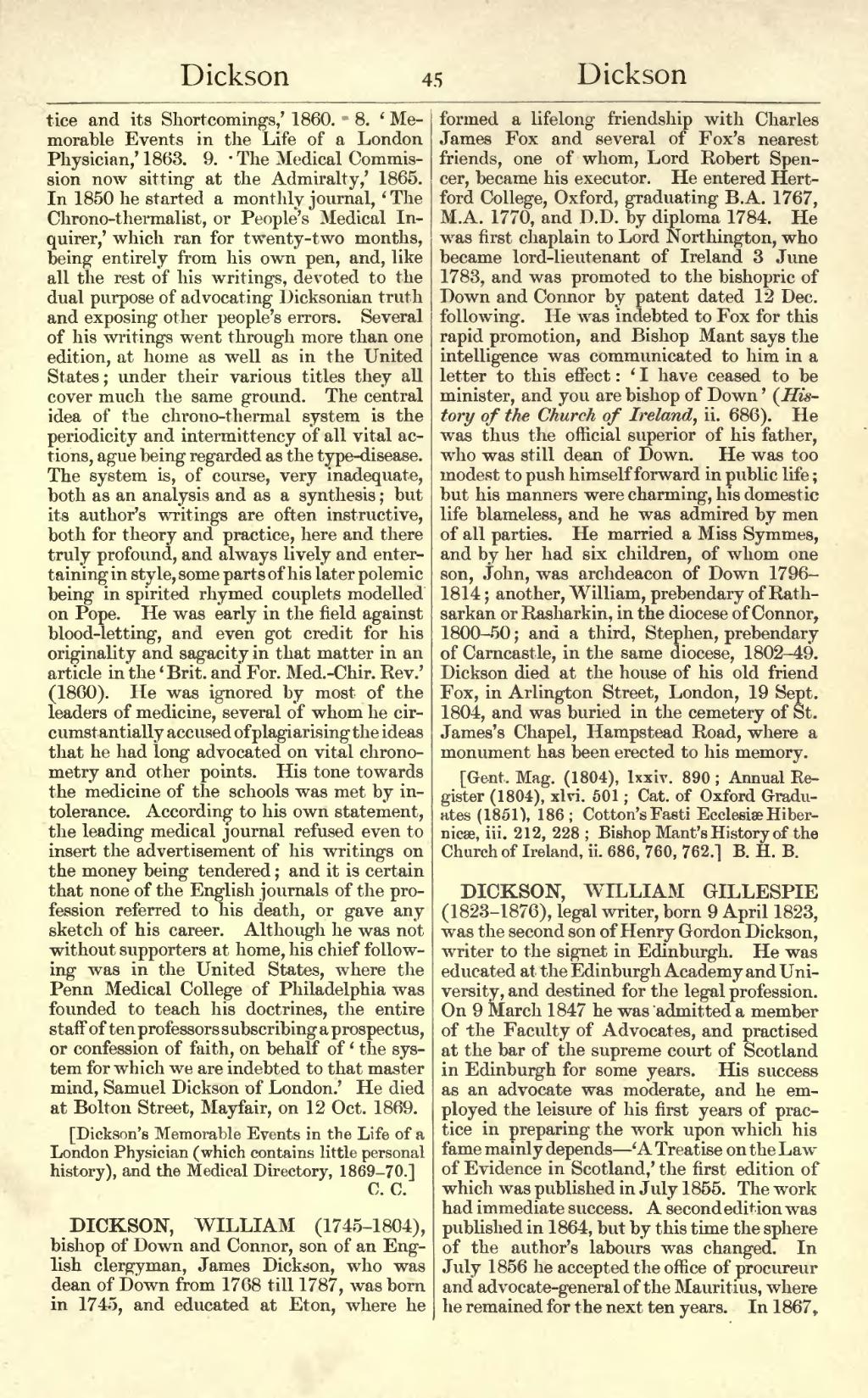- ‘Memorable Events in the Life of a London Physician,’ 1863.
- ‘The Medical Commission now sitting at the Admiralty,’ 1865.
tice and its Shortcomings,’ 1860.
In 1850 he started a monthly journal, ‘The Chrono-thermalist, or People's Medical Inquirer,’ which ran for twenty-two months, being entirely from his own pen, and, like all the rest of his writings, devoted to the dual purpose of advocating Dicksonian truth and exposing other people's errors. Several of his writings went through more than one edition, at home as well as in the United States; under their various titles they all cover much the same ground. The central idea of the chrono-thermal system is the periodicity and intermittency of all vital actions, ague being regarded as the type-disease. The system is, of course, very inadequate, both as an analysis and as a synthesis; but its author's writings are often instructive, both for theory and practice, here and there truly profound, and always lively and entertaining in style, some parts of his later polemic being in spirited rhymed couplets modelled on Pope. He was early in the field against blood-letting, and even got credit for his originality and sagacity in that matter in an article in the ‘Brit. and For. Med.-Chir. Rev.’ (1860). He was ignored by most of the leaders of medicine, several of whom he circumstantially accused of plagiarising the ideas that he had long advocated on vital chronometry and other points. His tone towards the medicine of the schools was met by intolerance. According to his own statement, the leading medical journal refused even to insert the advertisement of his writings on the money being tendered; and it is certain that none of the English journals of the profession referred to his death, or gave any sketch of his career. Although he was not without supporters at home, his chief following was in the United States, where the Penn Medical College of Philadelphia was founded to teach his doctrines, the entire staff of ten professors subscribing a prospectus, or confession of faith, on behalf of ‘the system for which we are indebted to that master mind, Samuel Dickson of London.’ He died at Bolton Street, Mayfair, on 12 Oct. 1869.
[Dickson's Memorable Events in the Life of a London Physician (which contains little personal history), and the Medical Directory, 1869–70.]
DICKSON, WILLIAM (1745–1804), bishop of Down and Connor, son of an English clergyman, James Dickson, who was dean of Down from 1768 till 1787, was born in 1745, and educated at Eton, where he formed a lifelong friendship with Charles James Fox and several of Fox's nearest friends, one of whom, Lord Robert Spencer, became his executor. He entered Hertford College, Oxford, graduating B.A. 1767, M.A. 1770, and D.D. by diploma 1784. He was first chaplain to Lord Northington, who became lord-lieutenant of Ireland 3 June 1783, and was promoted to the bishopric of Down and Connor by patent dated 12 Dec. following. He was indebted to Fox for this rapid promotion, and Bishop Mant says the intelligence was communicated to him in a letter to this effect: ‘I have ceased to be minister, and you are bishop of Down’ (History of the Church of Ireland, ii. 686). He was thus the official superior of his father, who was still dean of Down. He was too modest to push himself forward in public life; but his manners were charming, his domestic life blameless, and he was admired by men of all parties. He married a Miss Symmes, and by her had six children, of whom one son, John, was archdeacon of Down 1796–1814; another, William, prebendary of Rathsarkan or Rasharkin, in the diocese of Connor, 1800–50; and a third, Stephen, prebendary of Carncastle, in the same diocese, 1802–49. Dickson died at the house of his old friend Fox, in Arlington Street, London, 19 Sept. 1804, and was buried in the cemetery of St. James's Chapel, Hampstead Road, where a monument has been erected to his memory.
[Gent. Mag. (1804), lxxiv. 890; Annual Register (1804), xlvi. 501; Cat. of Oxford Graduates (1851), 186; Cotton's Fasti Ecclesiæ Hibernicæ, iii. 212, 228; Bishop Mant's History of the Church of Ireland, ii. 686, 760, 762.]
DICKSON, WILLIAM GILLESPIE (1823–1876), legal writer, born 9 April 1823, was the second son of Henry Gordon Dickson, writer to the signet in Edinburgh. He was educated at the Edinburgh Academy and University, and destined for the legal profession. On 9 March 1847 he was admitted a member of the Faculty of Advocates, and practised at the bar of the supreme court of Scotland in Edinburgh for some years. His success as an advocate was moderate, and he employed the leisure of his first years of practice in preparing the work upon which his fame mainly depends—‘A Treatise on the Law of Evidence in Scotland,’ the first edition of which was published in July 1855. The work had immediate success. A second edition was published in 1864, but by this time the sphere of the author's labours was changed. In July 1856 he accepted the office of procureur and advocate-general of the Mauritius, where he remained for the next ten years. In 1867,
